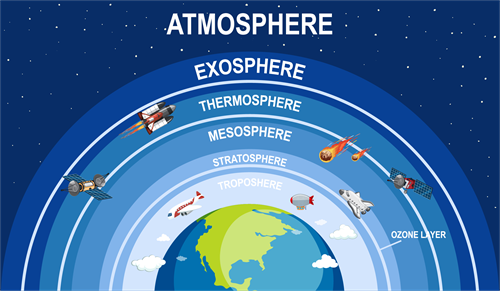
PUMPA - SMART LEARNING
எங்கள் ஆசிரியர்களுடன் 1-ஆன்-1 ஆலோசனை நேரத்தைப் பெறுங்கள். டாப்பர் ஆவதற்கு நாங்கள் பயிற்சி அளிப்போம்
Book Free Demo
Layers of the atmosphere
Troposphere:
The troposphere is the first layer of the atmosphere where we live. It lies closest to the surface and extends up to 16\ km above the earth. The movement of wind and cloud formation happens in this layer due to the presence of water vapour. This layer is responsible for the weather conditions on earth. At the times of bad weather and strong winds, aircrafts usually fly above this layer. The temperature in this layer decreases as the height (altitude) increases.
Stratosphere:
The stratosphere is the second layer of the atmosphere which lies above the troposphere and extends up to 50\ km above the earth's surface. Jet aircrafts and weather balloons fly within the stratosphere to avoid turbulence.
Ozone layer:
The ozone layer present in the stratosphere protects the life on earth from the sun's harmful ultraviolet (UV) rays. The ozone layer acts like a shield of the earth. The ozone molecules absorb these harmful UV radiations and heats this layer, thus producing a high temperature. But nowadays, this ozone layer is getting depleted due to environmental pollution.

Filtering of harmful radiations in the ozone layer
The depletion of the ozone layer affects human health in many ways. The ozone layer depletion may lead to skin cancer, eye cataracts, sunburns, and may also affect the immune systems in our bodies.
Mesosphere:
'Meso' means 'middle'. The mesosphere is the third layer which is located above the stratosphere. This layer extends up to 85\ km above the earth's surface. Most meteors that enter the earth's atmosphere gets vaporized in this layer.
Thermosphere:
'Thermo' means 'heat'. The fourth layer of the atmosphere, located above the mesosphere, is known as the thermosphere. This layer extends up to 500\ km from the earth's surface. International Space Station (ISS) orbits in this layer. Aurora occur in this region due to the ions present in that layer. Auroras or Polar lights are natural lights seen in the polar regions at night.

Auroras
Ionosphere:
This layer is a part of the thermosphere where the high energy radiations from the Sun collide with the gas molecules and make the electrons into free ions. These electrically charged particles create Auroras. Transmission of communication signals is possible due to the ions present in this region.
Exosphere:
The last and the outermost layer of the atmosphere surrounding the earth is the exosphere. 'Exo' means 'Outer'. This layer separates the other layers of the atmosphere from the outer space. This region has a very cold temperature. The exosphere starts from 500\ km and extends up to 10,000\ km above the surface of the earth.
Reference:
https://upload.wikimedia.org/wikipedia/commons/4/45/Tm-ozone-layer-05092021svg.svg